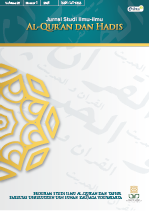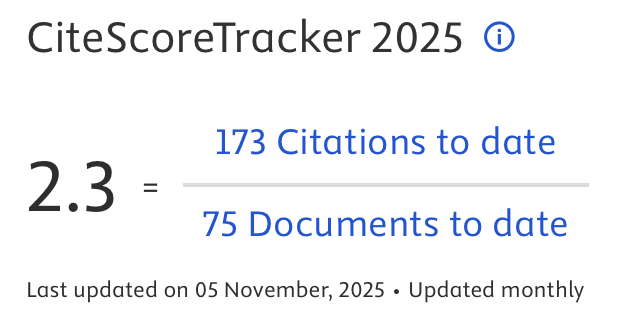AL- ṬAḤĀWĪ’S METHOD TOWARDS THE VARIETY OF QIRAĀT IN TAFSIR AḤKĀM AL-QUR’ĀN AND ITS IMPLICATION TO ISTINBĀṬ AL-AḤKĀM
DOI:
https://doi.org/10.14421/qh.2021.2201-05Keywords:
Keywords, Ah}kām al-Qur’ān al-Karīm, al-T{ah{āwī, the variety of Qur’an recitations.Abstract
The variety of Qiraāt is closely related to the interpretation of the Quran. Often, variety of Qiraāt result in different understanding and law. Al-Tahāwī gives special attention on the variety of Qiraāt and its use in the istinbāṭ of fiqh rulings in his interpretation entitled Ahkām al-Qur'ān al-Karīm. This research aims at investigating al-Tahāwī’s method towards the variety of Qiraāt and its implication in the istinbāṭ of fiqh rulings. This research paper employs analytic descriptive method by exploring and analyzing the variety of Qiraāt included in the interpretation entitled Ah}kām al-Qur’ān al-Karīm. The results showed that al-T{ah{āwī's interaction methods towards the variety of Qiraāt are: (1) providing all possible Qiraāt; (2) verifying the validity of Qiraāt; (3) explaining Qiraāt Syāżah. This method is very influential in the istinbāṭ of fiqh rulings because al-T{ah{āwī’s orientation on presenting variety of Qiraāt is related to the istinbāṭ of fiqh rulings itself. al-T{ah{āwī tried to compromise the variety of Qiraāt and confirmed his choices, far from being mażhab fanatics as those found in al-Jaṣāṣ, Ilkiyā al-Harāsi and Ibn al-‘Arabi.
Keywords: Ahkām al-Qur’ān al-Karīm, al-Tahāwī, the variety of Qur’an recitations, Fiqh rulings.
 Abstract viewed: 601 times
|
Abstract viewed: 601 times
|
 PDF downloaded = 462 times
PDF downloaded = 462 times
References
Al-‘Ak, Khalid Abd Al-Rahman. Usul al-Tafsir wa Qawaiduh, Damascus: Dar al-Nafais, 1994.
Ryvm,I o.k,hjmnb Al-‘Akri, Abd al-H}ay. Shadhara>t al-Dhahab. Vol. 1. Bairut: Dār al-Kutub al-‘Ilmiyyah, n.d.
Al-‘Aqi>qi>, Naji>b. al-Mustashriqu>n. Cairo: Da>r al-Ma‘a>rif, n.d.
Al-Ash‘ath, Abū Dāwud Sulaima>n Bin. Sunan Abu Dāwud, edited by Muḥammad Muḥyi al-Dīn Abd al- Ḥamīd. Vol. 2. Bairut: Dār al-Fikr, n.d. ‘
Al-Baihaqi>. Sunan al-Kubra, edited by Muh{ammad ‘Abd. Vol. 4. Makkah Mukarramah: Maktabah Dār al-Ba>z, 1994.
Al-Bir,‘Abd Alla>h Khu>shaid. Al-Qur’an wa ‘Ulu>muhu fi> al-Mis}. Cairo: Dār al-Ma‘rifah, 1970.
Al-Dhahabi>, Muh}ammad H{usain. Al-Tafsi>r wa al-Mufassiru>n. Vol. 1. Cairo: Maktabah Wahbah, 2000.
Al-Dhahabi>. Ma‘rifah al-Qurra>’ al-Kiba>r, edited by Bashsha>r ‘Awwad, al-Arna>’u>t, S}a>lih} Mahdi. Vol. 1. Bairut: Muassasah al-Risa>lah, 1404 H.
______. Siyar A‘la>m al-Nubala>’, edited by al-Arna>’u>t}. Vol. 15. Bairut: Muassasah al-Risa>lah, 1413 H.
Al-Faqi>r, Nu>h. ‘Ibq al-Raih}a>n fi> ‘Ulu>m al-Qur’a>n. n.p, 2001.
al-H{ajja>j, Abū al-H{usain Muslim bin. S}ah{i>h{ Muslim, edited by Muh{ammad Fuad Abd al-Ba>qi. Vol. 2. Bairut: Dār Ih}ya>’ al-‘Arabi>, n.d.
Al-Jazri>. Al-Nashr fi> al-Qira>aa>t al-‘Ashr, edited by ‘Ali Muh{ammmad al-D{aba>‘. Vol. 1. Bairut: Dār al-Fikr, n.d.
______. Gha>yah al-Niha>yah fi> T}baqa>t al-Qurra’. Vol. 1. Cairo: Maktabah al-Khanji>, 1351 H.
Al-Qat}t}a>n, Manna>‘. Maba>h}ith fi> ‘Ulu>m al-Qur’a>n. Riyadh: Maktabah al-Ma‘a>rif li al-Nashr wa al-Tauzi>‘,1992.
Al-Qurshi>, al-Jawa>hir al-Mud}i>’ah fi> T}abaqa>t al-Ha}nafiyyah. Karaci: Mi>r Muh}ammad Kutub Kha>n, n.d.
Al-S}a>lih{, S}ubh}i>. Maba>h}ith fi> ‘Ulu>m al-Qur’a>n. Bairut: Dār al-‘Ilm li al-Malayi>n, 2000.
Al-S}aimari>, Akhba>r Abi> H{ani>fah wa As}h}a>bih. Bairut: ‘Ala>m al-Kutub, 1985.
Al-Sam‘a>ni>. Al-Ansa>b, edited by Muh{ammad Abd al-Qa>dir ‘At}a. Vol. 2. Bairut: Dār al-Kutub al-Ilmiyyah, 1994.
Al-Suyu>t}i. al-It}qa>n fi> ‘Ulu>m al-Qur’a>n, edited by Sai>d al-Mandu>b. Vol. 1. Lebanon: Dār al-Fikr, 1996.
______. T}abaqa>t al-H}uffaz}. Bairut: Dār al-Kutub al-‘Ilmiyyah, 1403 H.
______. T}abaqa>t al-Mufassiri>n, edited by Ali Muh{ammad Umar. Cairo: Maktabah Wahbah, 1396 H.
Al-Syi>razi>. T}abaqa>t Al-Fuqaha>’, edited by Khali>l al-Mai>s. Vol. 1. Bairut: Dār al-Qalam, n.d.
Al-T{abari>, Ibn Jari>r. Ja>mi‘ al-Baya>n ‘an Ta’wi>l Ayi al-Qur’a>n. Vol. 1. Bairut: Dār al-Fikr,1405 H.
Al-T}aha>wi, Abu> Ja‘far. Ah}ka>m al-Qur’a>n al-Kari>m. edited by Sa‘ad al-Di>n Aunal. Vol. 1,2. Istambul: Manshu>ra>t al-Buh{u>th al-Isla>miyyah al-Ta>bi‘ li Waqf al-Diya>nah al-Turkiyyah, 1995.
_______. Mushkilah al-Atha>r, edited by al-Arna>’u>t. Vol. 1. Bairut: Muassasah al-Risa>lah, 1994.
Al-Tami>mi> Abu H{a>tim. Masha>hi>r ‘Ulama>’ al-Ams{a>r, edited by M. Fleishhammer. Vol. 1. Bairut: Dār al-Kutub al-‘Ilmiyyah, 1959.
Al-Zamakhshari>. Asa>s al-Bala>gha>h. Bairut: Dār al-S}a>dir, 1965.
Al-Zarqa>ni. Mana>hil al-‘Irfa>n. Vol. 1. Bairut: Dār al-Fikr, 1996.
Brockelmann. Tari. Translated in Arabic by ‘Abd al-H{alir. Vol. 3. Cairo: Dār al-Ma‘rifah, n.d.
Farha>t, Ahmad H{asan. Makki Abu> T}alib wa Tafsi>r al-Qur’a>n. Amman Jordan: Da>r al-Furqa>n, 1983.
Fauzi, Ahmad.“Problema Qirā’āt Dalam Al-Qur’an Perspekstif Muh{ammad Shah{rūr” Jurnal Studi Ilmu-Ilmu al-Qur’an dan Hadis, Vol. 20, No. 1, (Januari 2019): 102. https://doi.org/10.14421/qh.2019.2001-05
Goldziher, Ignaz. Madha>hib al-Tafsi>r al-Isla>mi>. Translated in Arabic by ‘Abd al-H{alir. Cairo: Maktabah al-Khanji>, 1955.
Halimah B. “Perbedaan Qira’at Dan Pengaruhnya Dalam Istinbath Hukum”, Jurnal Al-Risalah, Vol 19 No. 1 (Mei 2019): 97-109 http://journal.uin-alauddin.ac.id/index.php/al_risalah/article/view/9759
Harvey, Ramon. “The Legal Epistemology of Qur’anic Variants:The Readings of Ibn Masʿūd in Kufan fiqh and the Ḥanafī Madhhab”, in Journal of Qur’anic Studies 19.1(2017):72-101 http://www.euppublishing.com/doi/abs/10.3366/jqs.2017.0268
Hidayatulloh, Miftah Khilmi. “Qiraāt Pada Ayat-Ayat Ahkām Dan Pengaruhnya Terhadap Hukum Fikih”, Jurnal Syahadah, Vol. V, No. 1, (April 2017): 131-154 https://doi.org/10.32520/syhd.v5i1.130
Ibn al-Manz}u>r. Lisa>n al-‘Arab. Vol. 14. Bairut: Dār Ih}ya>’ al-Turath, 1997.
Ibn al-Nadīm. Al-Fahrasat. Vol. 1. Bairut: Dār al-Ma‘rifah, 1978.
Ibn Kathīr. Al-Bida>yah wa al-Niha>yah. Vol. 11. Bairut: Dār al-Fikr, 1986.
Ibn Khallika>n, Wafayāt al-A‘yān wa Anbāʾ al-Zamān, edited by Ih{sa>n ‘Abba>s. Vol. 1. Bairut: Dār al-Thaqa>wah, 1968.
Jama>‘ah min Kiba>r al-Lughawiyyi>n al-‘Arab. Al-Mu‘jam al-‘Arabi> al-Asa>si>. Al-Munaz{z{mah al-‘Arabiyyah li al-Tarbiyyah wa al-Thaqafah wa al-‘Ulu>m, Mat{ba‘ah La>ru>s, n.d.
Khali>fish, Shafwat Musht{afa. Al-Ima>m Abu Bakr al-Ra>zi> al-Jas}s}a>}s }wa Manhajuhu fi> al-Tafsi>r. Cairo: Dār al-Sala>m, 2001.
Ma{mu>d, Abd Al-Maji>d. Abu> Ja‘far Al-T}aha>wi wa Atharuh fi> al-H{adith. Cairo: al-Haiah al-Mis}riyyah al-‘Amma>h li> al-Kita>b, 1975.
Metz, Adam. Al-H}ad}arah al-Isla>miyyah fi al-Qarn al-Ra>bi‘ al-Hijri>. Translated in Arabic by Muh}ammad Abd al-Ha>di Abu Raidah. Vol. 1. Cairo: Maktabah Lajnah al-Ta’li>f wa al-Tarjamah wa al-Nashr, 1941.
Ningrum, Dewi Aprilia. "Ahruf Sab’ah: Sejarah dan Eksistensinya", Journal Of Qur'a>n And Hadi>th Studies, Vol. 8 No. 1, January-(June 2019): 87. https://doi.org/10.15408/quhas.v8i1.13385
Razali, Mohd A’Tarahim Mohd at al. “Khilaf Qiraat Mutawatirah: Satu Analisa Pada Ayat Haid Dari Aspek Peranan, Perkaitan Dan Pertalian Pada Hukum Fiqh”, Jurnal Islam dan Masyarakat Kontemporari,. 14 (Januari 2017): 81-97 https://journal.unisza.edu.my/jimk/index.php/jimk/article/view/199
Downloads
Published
How to Cite
Issue
Section
License
Publishing your paper with Jurnal Studi Ilmu-ilmu al-Qur'an dan Hadis means that the author or authors retain the copyright in the paper. Jurnal Studi Ilmu-ilmu al-Qur'an dan Hadis uses license CC-BY-NC-ND or an equivalent license as the optimal license for the publication, distribution, use, and reuse of scholarly works. This license permits anyone to copy and redistribute the material in any medium or format and must give appropriate credit, provide a link to the license, and indicate if changes were made. If you remix, translate, transform or build upon the material you may use it for private use only and not for distribution. Jurnal Studi Ilmu-ilmu al-Qur'an dan Hadis granted an exclusive non-commercial reuse license by the author(s), but the author(s) are able to put the paper onto a website, distribute it to colleagues, give it to students, use it in your thesis, etc, so long as the use is not directed at a commercial advantage or toward private monetary gain. The author(s) can reuse the figures and tables and other information contained in their paper published by Jurnal Studi Ilmu-ilmu al-Qur'an dan Hadis in future papers or work without having to ask anyone for permission, provided that the figures, tables, or other information that is included in the new paper or work properly references the published paper as the source of the figures, tables or other information, and the new paper or work is not direct at a private monetary gain or commercial advantage.
Jurnal Studi Ilmu-ilmu al-Qur'an dan Hadis journal Open Acces articles are distrubuted under the Creative Commons Attribution-NonCommercial-NoDerivatives 4.0 International (CC BY-NC-ND 4.0). Article can be read, copy and redistribute the material ini any medium or format under the following conditions:
Attribution — You must give appropriate credit, provide a link to the license, and indicate if changes were made. You may do so in any reasonable manner, but not in any way that suggests the licensor endorses you or your use.
NonCommercial — You may not use the material for commercial purposes.
NoDerivatives — If you remix, transform, or build upon the material, you may not distribute the modified material.










